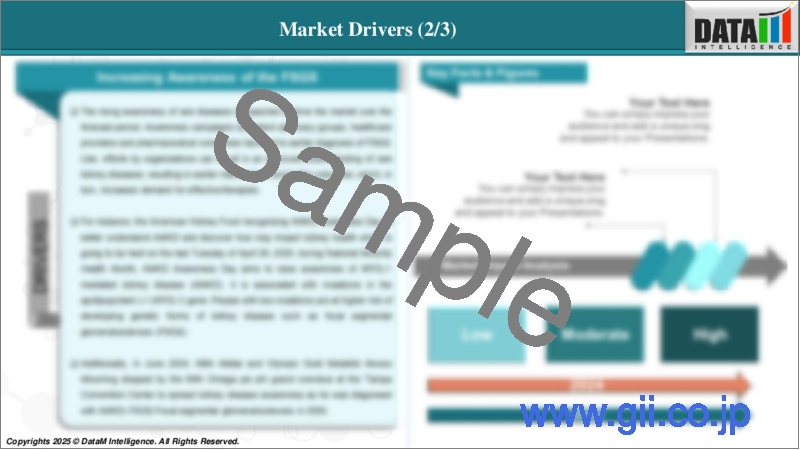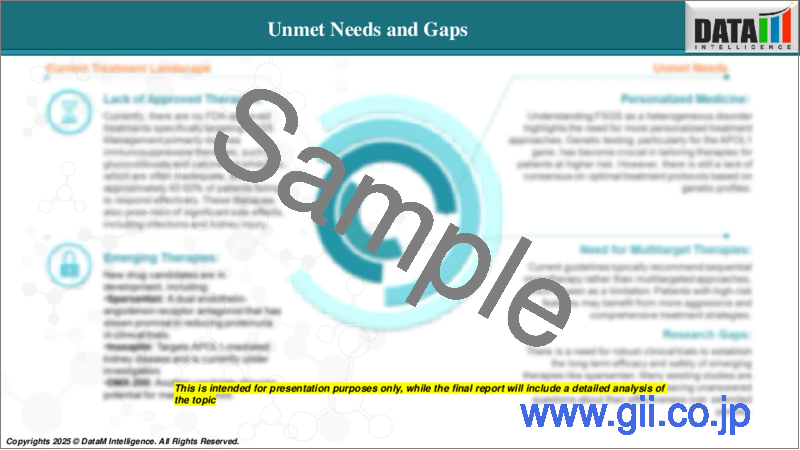|
|
市場調査レポート
商品コード
1683384
日本のヘルスケアにおけるAI市場:2025年~2033年Japan AI in Healthcare Market - 2025-2033 |
||||||
カスタマイズ可能
適宜更新あり
|
|||||||
| 日本のヘルスケアにおけるAI市場:2025年~2033年 |
|
出版日: 2025年03月20日
発行: DataM Intelligence
ページ情報: 英文 176 Pages
納期: 即日から翌営業日
|
- 全表示
- 概要
- 目次
日本のヘルスケアにおけるAIの市場規模は、2024年に14億2,000万米ドルに達し、2033年には148億米ドルに達すると予測され、予測期間の2025年から2033年のCAGRは36.5%になる見込みです。
日本のヘルスケアにおけるAI市場は、診断、治療計画、医薬品開発、患者管理システムの強化に人工知能(AI)技術を活用することで、ヘルスケア分野を変革しています。AIはX線、CTスキャン、MRIスキャンなどの医療画像を分析し、診断精度とスピードを向上させる。LPixelや富士フイルムのような企業がこの分野をリードしており、AIアルゴリズムは人間の目には見えないような異常を検出することができます。
AIは医療画像のパターンを特定することでがんの早期発見に役立ち、診断結果を大幅に改善します。AIは、患者のデータや病歴を分析することで、病気の進行を予測し、予防医療に役立てることができます。この予測能力は、ヘルスケアプロバイダーが慢性疾患を管理するための事前対策を講じたり、遺伝子プロファイルや病歴に基づいて個々の患者に合わせた治療を行ったりするのに役立ち、治療効果や患者の転帰を向上させます。
技術的進歩は、予測期間における日本のヘルスケアにおけるAI市場の成長を促進すると予想されます。日本のAIヘルスケアスタートアップシーンは急速に成長しており、がん、インフルエンザ、心臓病などの疾患の診断スピードと精度の向上を目指した新しいツールが登場しています。しかし、こうしたAIツールの統合は、新製品の承認プロセスに時間がかかるなどの課題に直面しています。こうしたハードルにもかかわらず、倫理的リスクを管理し、基準を設定する世界の取り組みが障壁を克服する助けとなり、日本のヘルスケアシステムを強化するAIの役割が促進されることが期待されます。
日本のヘルスケア分野におけるAIの統合は、診断・治療プロセスを変革しつつあります。主な分野には、がんなどの病気を発見する精度を向上させる医療用画像診断、治療を個別化し病気の進行を予測する予測分析、手術や看護支援を支援するヘルスケアロボットなどがあります。これらの技術は、日本の高齢化や労働力不足といった課題に対処するものです。成長促進要因としては、AIの進歩、政府の支援、市場の潜在力などが挙げられ、2027年までに大幅な拡大が予測されています。AIは、精度、効率、患者の治療成果を向上させることで、ヘルスケアに革命をもたらしています。
さらに、業界の主要企業は、日本のヘルスケアにおけるAI市場の成長を促進する革新的な発売を開始する必要があります。例えば、2024年11月、日本は次世代薬剤設計、ヘルスケアロボット、デジタルヘルスプラットフォームに焦点を当て、ヘルスケア技術で急速に進歩しています。AIを活用することで、高齢化や医療従事者の不足といったさまざまな課題に取り組むとともに、医療の質の向上を目指しています。
当レポートでは、日本のヘルスケアにおけるAI市場について調査し、市場の概要とともに、コンポーネント別、技術別、用途別、エンドユーザー別動向、競合情勢、および市場に参入する企業のプロファイルなどを提供しています。
目次
第1章 市場のイントロダクションと範囲
第2章 エグゼクティブの洞察と重要なポイント
第3章 市場力学
- 影響要因
- 促進要因
- 抑制要因
- 機会
- 影響分析
第4章 戦略的洞察と業界の展望
- 市場のリーダーと先駆者
- CXOの視点
- 最新の開発とブレークスルー
- ケーススタディ/進行中の調査
- 規制と償還の情勢
- ポーターのファイブフォース分析
- サプライチェーン分析
- 特許分析
- SWOT分析
- アンメットニーズとギャップ
- 市場参入と拡大のための推奨戦略
- シナリオ分析ベストケース、ベースケース、ワーストケースの予測
- 価格分析と価格動向
- キーオピニオンリーダー
第5章 日本のヘルスケアにおけるAI市場、コンポーネント別
- ハードウェア
- ソフトウェアソリューション
- サービス
第6章 日本のヘルスケアにおけるAI市場、技術別
- 機械学習
- 自然言語処理
- コンテキスト認識コンピューティング
- コンピュータビジョン
第7章 日本のヘルスケアにおけるAI市場、用途別
- 集中治療
- ロボット支援手術
- バーチャル看護アシスタント
- 管理ワークフローアシスタント
- 不正行為検出
- サイバーセキュリティ
- 投薬ミスの削減
- 医療診断
- 精密医療
- 医薬品の発見と開発
- 遠隔患者モニタリング
- ウェアラブル
- その他
第8章 日本のヘルスケアにおけるAI市場、エンドユーザー別
- 医療機関
- ヘルスケア支払者
- ヘルスケア企業
- 患者
- その他
第9章 競合情勢と市場ポジショニング
第10章 企業プロファイル
- FUJITSU
- Microsoft
- Cyberdyne Care Robotics GmbH
- LPIXEL.
- Rakuten Group, Inc.
- MOLCURE Inc.
- Medmain Inc.
- AI Medical Service Inc.
第11章 仮定と調査手法
第12章 付録
The Japan AI in healthcare market reached US$ 1.42 billion in 2024 and is expected to reach US$ 14.8 billion by 2033, growing at a CAGR of 36.5% during the forecast period 2025-2033.
Japan's AI in the healthcare market is transforming the healthcare sector by leveraging artificial intelligence (AI) technologies to enhance diagnostics, treatment planning, drug development, and patient management systems. AI analyzes medical images such as X-rays, CT scans, and MRI scans to improve diagnostic accuracy and speed. Companies like LPixel and Fujifilm Corporation are leading in this area, with AI algorithms capable of detecting abnormalities that may not be visible to the human eye.
AI helps in the early detection of cancers by identifying patterns in medical images, significantly improving diagnostic outcomes. AI can predict disease progression and aid in preventive medicine by analyzing patient data and medical histories. This predictive capability helps healthcare providers take proactive measures to manage chronic conditions and aids in tailoring treatments to individual patients based on genetic profiles and medical histories, enhancing treatment effectiveness and patient outcomes.
Market Dynamics: Drivers & Restraints
Technological Advancements
The technological advancements are expected to drive the growth of Japan's AI in the healthcare market in the forecast period. Japan's AI healthcare start-up scene is rapidly growing, with new tools aimed at improving diagnostic speed and accuracy for diseases like cancer, influenza, and heart disease. However, integrating these AI tools faces challenges, such as a lengthy approval process for new products. Despite these hurdles, global efforts to manage ethical risks and set standards are expected to help overcome barriers, facilitating AI's role in enhancing Japan's healthcare system.
AI integration in Japan's healthcare sector is transforming diagnostic and treatment processes. Key areas include medical imaging for improved accuracy in detecting diseases like cancer, predictive analytics to personalize treatments and predict disease progression, and healthcare robotics for assisting surgeries and nursing support. These technologies address challenges like Japan's aging population and labor shortages. Growth drivers include advancements in AI, government support, and the market's potential, with forecasts showing significant expansion by 2027. AI is revolutionizing healthcare by enhancing precision, efficiency, and patient care outcomes.
Additionally, key players in the industry should launch innovative launches that would drive Japan's AI in the healthcare market growth. For instance, in November 2024, Japan is rapidly advancing in healthcare technology, focusing on next-generation drug design, healthcare robotics, and digital health platforms. Leveraging AI, the country aims to tackle various challenges, such as its aging population and shortage of healthcare workers, while improving the quality of medical care.
Also, in June 2024, SoftBank Group launched a joint venture with Tempus AI, named SB Tempus, aimed at transforming healthcare in Japan through AI-powered precision medicine. The partnership will utilize AI to analyze personal medical data, including genetic information, to offer personalized treatment plans. With an initial focus on oncology, this venture will help tailor targeted therapies, improving healthcare outcomes.
Data Privacy Concerns
Data privacy and regulatory challenges are major barriers to the integration of AI technologies into Japan's healthcare market. As AI becomes increasingly prevalent in areas like diagnostics, predictive analytics, and personalized medicine, it creates new risks surrounding the security and use of sensitive health data, including medical records, genetic data, and patient histories.
Japan's strict privacy laws, such as the Act on the Protection of Personal Information (APPI), impose significant requirements on healthcare providers to ensure patient data is secure and only shared with patient consent. However, AI systems often require vast amounts of data to function effectively, which raises concerns about data breaches, identity theft, and misuse of information. Thus, the above factors could be limiting Japan's AI in the healthcare market's potential growth.
Segment Analysis
The Japan AI in the healthcare market is segmented based on component, technology, application, and end-user.
Component:
The software solutions segment in the component is expected to dominate the Japan AI in the healthcare market share
The software solutions segment in Japan's AI in Healthcare market revolves around the development and deployment of AI-powered software designed to improve the efficiency, accuracy, and overall effectiveness of various healthcare functions, including diagnostics, treatment planning, and patient management. These solutions are pivotal in enhancing patient outcomes and streamlining healthcare processes.
AI-driven algorithms are used to enhance the analysis of medical images such as X-rays, CT scans, and MRIs, aiding in quicker and more precise diagnoses. Companies like LPixel and Fujifilm Corporation are at the forefront of applying AI to detect abnormalities, such as tumors or cardiovascular conditions. AI tools analyze vast amounts of patient data to predict potential diseases or health risks. By leveraging patient history, genetic information, and other medical records, these systems enable personalized treatment plans and early interventions, ultimately improving patient care outcomes.
Additionally, key players in the industry have innovative launches that would drive this segment growth in the Japan AI in healthcare market. For instance, in November 2023, RapidAI, a health tech company, received Class III Shonin clearance in Japan, allowing it to launch its Rapid Edge Cloud platform and a non-contrast CT tool for stroke identification. RapidAI's offerings include diagnostic solutions for stroke, aneurysms, and pulmonary embolisms. It also provides technology platforms for coordinated care between hospitals and EMS providers, analytics software for hospital operations, and a clinical trial platform to streamline screening and enrollment. These factors have solidified the segment's position in the Japanese AI in healthcare market.
Competitive Landscape
The major players in the Japan AI in healthcare market include IBM, FUJITSU, Microsoft, Cyberdyne Care Robotics GmbH, LPIXEL., Rakuten Group, Inc., MOLCURE Inc., Medmain Inc., and AI Medical Service Inc., among others.
Key Developments
- In November 2024, NVIDIA launched the BioNeMo framework to accelerate digital biology for the biopharma sector. This open-source platform is designed to help researchers in drug discovery and molecular design by scaling AI models for biomolecular research. The framework includes tools that enable the rapid development of large-scale models, such as AlphaFold2 for protein structure prediction and DiffDock 2.0 for faster and more accurate molecular docking predictions. The platform supports integration with existing high-performance computing systems, significantly enhancing research capabilities.
Why Purchase the Report?
- Pipeline & Innovations: Reviews ongoing clinical trials and product pipelines and forecasts upcoming advancements in medical devices and pharmaceuticals.
- Product Performance & Market Positioning: Analyze product performance, market positioning, and growth potential to optimize strategies.
- Real-World Evidence: Integrates patient feedback and data into product development for improved outcomes.
- Physician Preferences & Health System Impact: Examines healthcare provider behaviors and the impact of health system mergers on adoption strategies.
- Market Updates & Industry Changes: This covers recent regulatory changes, new policies, and emerging technologies.
- Competitive Strategies: Analyze competitor strategies, market share, and emerging players.
- Pricing & Market Access: Reviews pricing models, reimbursement trends, and market access strategies.
- Market Entry & Expansion: Identifies optimal strategies for entering new markets and partnerships.
- Regional Growth & Investment: Highlights high-growth regions and investment opportunities.
- Supply Chain Optimization: Assesses supply chain risks and distribution strategies for efficient product delivery.
- Sustainability & Regulatory Impact: Focuses on eco-friendly practices and evolving regulations in healthcare.
- Post-market Surveillance: Uses post-market data to enhance product safety and access.
- Pharmacoeconomics & Value-Based Pricing: Analyzes the shift to value-based pricing and data-driven decision-making in R&D.
The Japan AI in Healthcare Market report delivers a detailed analysis with 60+ key tables, more than 50 visually impactful figures, and 176 pages of expert insights, providing a complete view of the market landscape.
Target Audience 2024
- Manufacturers: Pharmaceutical, Medical Device, Biotech Companies, Contract Manufacturers, Distributors, Hospitals.
- Regulatory & Policy: Compliance Officers, Government, Health Economists, Market Access Specialists.
- Technology & Innovation: AI/Robotics Providers, R&D Professionals, Clinical Trial Managers, Pharmacovigilance Experts.
- Investors: Healthcare Investors, Venture Fund Investors, Pharma Marketing & Sales.
- Consulting & Advisory: Healthcare Consultants, Industry Associations, Analysts.
- Supply Chain: Distribution and Supply Chain Managers.
- Consumers & Advocacy: Patients, Advocacy Groups, Insurance Companies.
- Academic & Research: Academic Institutions.
Table of Contents
1. Market Introduction and Scope
- 1.1. Objectives of the Report
- 1.2. Report Coverage & Definitions
- 1.3. Report Scope
2. Executive Insights and Key Takeaways
- 2.1. Market Highlights and Strategic Takeaways
- 2.2. Key Trends and Future Projections
- 2.3. Snippet by Component
- 2.4. Snippet by Technology
- 2.5. Snippet by Application
- 2.6. Snippet by End-User
3. Dynamics
- 3.1. Impacting Factors
- 3.1.1. Drivers
- 3.1.1.1. Technological Advancements
- 3.1.1.2. Rising Aging Population and Healthcare Needs
- 3.1.2. Restraints
- 3.1.2.1. Data Privacy Concerns
- 3.1.2.2. Stringent Regulatory Environment
- 3.1.3. Opportunity
- 3.1.3.1. Investment in Precision Medicine
- 3.1.4. Impact Analysis
- 3.1.1. Drivers
4. Strategic Insights and Industry Outlook
- 4.1. Market Leaders and Pioneers
- 4.1.1. Emerging Pioneers and Prominent Players
- 4.1.2. Established leaders with largest-selling Brand
- 4.1.3. Market leaders with established Product
- 4.2. CXO Perspectives
- 4.3. Latest Developments and Breakthroughs
- 4.4. Case Studies/Ongoing Research
- 4.5. Regulatory and Reimbursement Landscape
- 4.5.1. North America
- 4.5.2. Europe
- 4.5.3. Asia Pacific
- 4.5.4. Latin America
- 4.5.5. Middle East & Africa
- 4.6. Porter's Five Forces Analysis
- 4.7. Supply Chain Analysis
- 4.8. Patent Analysis
- 4.9. SWOT Analysis
- 4.10. Unmet Needs and Gaps
- 4.11. Recommended Strategies for Market Entry and Expansion
- 4.12. Scenario Analysis: Best-Case, Base-Case, and Worst-Case Forecasts
- 4.13. Pricing Analysis and Price Dynamics
- 4.14. Key Opinion Leaders
5. Japan AI in Healthcare Market, By Component
- 5.1. Introduction
- 5.1.1. Analysis and Y-o-Y Growth Analysis (%), By Component
- 5.1.2. Market Attractiveness Index, By Component
- 5.2. Hardware*
- 5.2.1. Introduction
- 5.2.2. Market Size Analysis and Y-o-Y Growth Analysis (%)
- 5.3. Software Solutions
- 5.4. Services
6. Japan AI in Healthcare Market, By Technology
- 6.1. Introduction
- 6.1.1. Market Size Analysis and Y-o-Y Growth Analysis (%), By Technology
- 6.1.2. Market Attractiveness Index, By Technology
- 6.2. Machine Learning*
- 6.2.1. Introduction
- 6.2.2. Market Size Analysis and Y-o-Y Growth Analysis (%)
- 6.3. Natural Language Processing
- 6.4. Context-Aware Computing
- 6.5. Computer Vision
7. Japan AI in Healthcare Market, By Application
- 7.1. Introduction
- 7.1.1. Market Size Analysis and Y-o-Y Growth Analysis (%), By Application
- 7.1.2. Market Attractiveness Index, By Application
- 7.2. Critical Care*
- 7.2.1. Introduction
- 7.2.2. Market Size Analysis and Y-o-Y Growth Analysis (%)
- 7.3. Robot-Assisted Surgery
- 7.4. Virtual Nursing Assistants
- 7.5. Administrative Workflow Assistants
- 7.6. Fraud Detection
- 7.7. Cybersecurity
- 7.8. Dosage Error Reduction
- 7.9. Medical Diagnostics
- 7.10. Precision Medicine
- 7.11. Drug Discovery & Development
- 7.12. Remote Patient Monitoring
- 7.13. Wearables
- 7.14. Others
8. Japan AI in Healthcare Market, By End-User
- 8.1. Introduction
- 8.1.1. Market Size Analysis and Y-o-Y Growth Analysis (%), By End-User
- 8.1.2. Market Attractiveness Index, By End-User
- 8.2. Healthcare Providers*
- 8.2.1. Introduction
- 8.2.2. Market Size Analysis and Y-o-Y Growth Analysis (%)
- 8.3. Healthcare Payers
- 8.4. Healthcare Companies
- 8.5. Patients
- 8.6. Others
9. Competitive Landscape and Market Positioning
- 9.1. Competitive Overview and Key Market Players
- 9.2. Market Share Analysis and Positioning Matrix
- 9.3. Strategic Partnerships, Mergers & Acquisitions
- 9.4. Key Developments in Product Portfolios and Innovations
- 9.5. Company Benchmarking
10. Company Profiles
- 10.1. IBM *
- 10.1.1. Company Overview
- 10.1.2. Product Portfolio
- 10.1.2.1. Product Description
- 10.1.2.2. Product Key Performance Indicators (KPIs)
- 10.1.2.3. Historic and Forecasted Product Sales
- 10.1.2.4. Product Sales Volume
- 10.1.3. Financial Overview
- 10.1.3.1. Company Revenue's
- 10.1.3.2. Geographical Revenue Shares
- 10.1.3.3. Revenue Forecasts
- 10.1.4. Key Developments
- 10.1.4.1. Mergers & Acquisitions
- 10.1.4.2. Key Product Development Activities
- 10.1.4.3. Regulatory Approvals, etc.
- 10.1.5. SWOT Analysis
- 10.2. FUJITSU
- 10.3. Microsoft
- 10.4. Cyberdyne Care Robotics GmbH
- 10.5. LPIXEL.
- 10.6. Rakuten Group, Inc.
- 10.7. MOLCURE Inc.
- 10.8. Medmain Inc.
- 10.9. AI Medical Service Inc.
LIST NOT EXHAUSTIVE
11. Assumption and Research Methodology
- 11.1. Data Collection Methods
- 11.2. Data Triangulation
- 11.3. Forecasting Techniques
- 11.4. Data Verification and Validation
12. Appendix
- 12.1. About Us and Services
- 12.2. Contact Us






